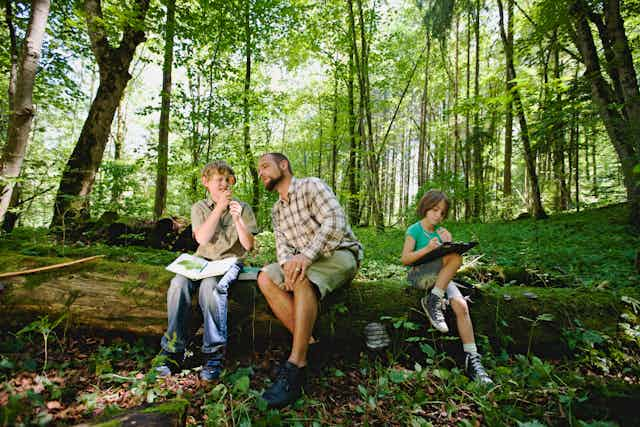Climate change is arguably the single most important issue facing the planet over the next century. Today’s school students will be the ones who must reverse it, cope with it as best they can, or experience its consequences.
We know students feel engaged and passionate about global issues like this, now adults have to work much harder to make school courses relevant and real. Challenging students to tackle “live” data and watch climate change in action is one way to approach this.
To take one example, let’s look at the natural “cycles” of two key substances: water and carbon. Both are absolutely crucial to how the natural world works, and both have been badly disrupted by human activity. Understanding climate change is impossible without grasping what has happened to the water and carbon cycles, but unfortunately, as you may remember from school yourself, these are not the most thrilling topics.

Globally, the two collide at the cellular level in tiny pores in the leaves of plants through which CO₂ enters before processing by photosynthesis. Importantly, while CO₂ enters the plant, water leaves in transpiration. As CO₂ levels rise, plants can choose whether to take advantage of this artificial, human-driven fertilisation and fix more carbon (grow faster), or reduce water loss and deal with drought more efficiently.
In contrast, these naturally intermeshed carbon and water cycles do not collide in the English and Welsh school system. There, pupils are taught that carbon dioxide is taken into plants and feeds the carbon cycle while, entirely separately, in the water cycle, transpiration injects water into the atmosphere, affecting cloud cover and so the balance between cooling and warming. Climate change cannot be understood without an appreciation of how human actions are affecting all sorts of interlocking natural cycles, and colleagues and I hope that, as researchers, we can help school teachers to join these dots in the classroom.
It’s true that talking about carbon and water cycles can seem abstract and disconnected from the exciting and forward-looking parts of the curriculum such as medical advances or molecular biology. But colleagues and I want to change that perception by engaging 15 and 16-year-old students in climate change research, enabling them to use real data to understand these cycles and how they relate to climate change. The materials are being rolled out this term in a pilot programme at a school linked to the University of Birmingham.
These approaches are particularly timely. The new high school science courses in England and Wales (known as GCSEs) have a much greater emphasis on applying knowledge and ideas to unfamiliar scenarios as well as analysing and evaluating information than previous courses.
One of the aims of the biology course, for instance, is to develop curiosity in the natural world and to encourage pupils to appreciate the relevance of biology to their everyday lives. These skills can be difficult to achieve in a classroom – especially as teachers are under pressure to just “get through” a seemingly ever-growing body of knowledge that pupils must understand and remember.
Using materials we have developed, pupils have been able – in just one lesson – to make links between topics such as environmental change and the cycling of materials, or plant cell organisation and photosynthesis and transpiration. At the same time they are also getting to grips with large data sets and experimental design on a grand and unfamiliar scale.
This data comes from Birmingham’s FACE project, which is fertilising a forest of mature oak trees with extra carbon dioxide on a huge scale. For at least the next decade, rings of 35m-high pylons will feed the trees extra CO₂ to see how such forests might respond to a carbon-rich atmosphere.

At this point, we have some information from lab studies but real experiments out in the forests are rare and have never looked at UK oak forests. What is clear is that the global consequences of climate change will be mediated through trees, as they balance the uptake of CO₂ with water loss and in turn directly affect any further global warming.
This is not an ivory tower experiment – the forest is wired and connected to the digital world, and pupils will be able to explore the experiment themselves online and monitor its progress in real time. Data sets can be downloaded and used in the classroom to directly address the water and carbon cycle aspect of the syllabus. Direct participation with this high tech research enriches both the school experience and the science itself in a two-way process.
Trees get bigger as photosynthesis takes carbon from the atmosphere, but they shrink as water is lost through the open pores. So over months and years tree trunks get thicker, but they shrink and expand over a daily cycle. Here in a single organism the consequences of elevated CO₂ for carbon and water cycles are played out and captured in a single lesson plan.
We hope that this sort of interactive, citizen science approach will revolutionise the study of ecosystems and climate change. This is an opportunity for students not just to learn about how science is progressing but to directly participate – ultimately, we aim not just to transmit knowledge, but to inspire action.

